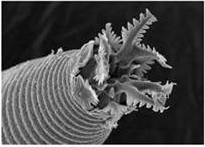
Unseen and Underfoot: the Hidden Diversity of the Plains
A unique photography exhibit featuring both the above-ground and below-ground beauty and diversity of our Nebraska prairies and plains.
This exhibit will be presented August 31 through September 30 at the WallSpace-LNK Gallery in Lincoln. Gallery hours are 12 – 5 pm every Thursday, Friday and Saturday, with extended hours on First Friday (September 1) 12 – 8 pm.
Pictured- the head of an Acrobeles nematode, as photographed using scanning electron microscopy at approximately 5,000x magnification. This nematode is found in soil from many Nebraskan prairie sites.
Tom Powers, Nebraska nematologist based at UNL, explains the idea for this show as “an outgrowth of a conversation I had with a wildlife photographer who had an exhibit showing the beauty and diversity of the prairie. I told him that he was only seeing half of the story. So he challenged me to show the other half.” Dr. Powers’ lab routinely samples soil from various sites, often prairies, to collect nematodes- microscopic worms that are present in all habitats on the planet. They are the most abundant multi-cellular animals on earth but are overlooked and under-appreciated due to their small size and subterranean habitat. This exhibit seeks to change that by showcasing the variety, strangeness and beauty of these belowground creatures and pairs them with images of the above-ground prairie community.
There are eight selected prairie sites and one exceptionally unique locality featured in the exhibit. Four sites are from around Lincoln. They are Lincoln’s Pioneers Park, the Lancaster County Prairie Corridor, Nine-Mile Prairie just west of Lincoln Airpark, and Spring Creek Audubon Center near Denton. Other Nebraska prairies sampled are Wachiska Audubon’s Tim Knott Prairie by Omaha, Willa Cather Prairie in Red Cloud, Switzer Ranch, near Calamus Reservoir, Crescent Lake National Wildlife Refuge and the Alkaline Lakes in the western Nebraska Sandhills. The non-Nebraskan site is the McMurdo Dry Valleys of Antarctica.
The focus on nematodes of the prairie expands the sense of place in our landscapes. The diversity in the prairie nematode communities reflects the aboveground diversity of the plants and geologic events that shaped the land. If you plow up the prairie, thousands of years of records contained within the nematode community are lost. Conversely, an unplowed prairie soil community will change incrementally in concert with other members of the community. Each member, or species, carries its own genealogical history within its DNA.
Nematodes are noteworthy for many reasons. Recently the news of a 26,000 year-old nematode revived from Siberian frozen tundra stimulated discussion of the limits of life. A nematode discovered in California’s Mono Lake was found to tolerate levels of arsenic 500 times the lethal dose for humans. Caenorhabditis elegans, the first multicellular animal to have its entire genome sequenced and a model organism for developmental biology, is actively used in aging studies for humans. Nematodes that feed on plants can cause severe crop losses. The presence of a single potato cyst nematode in a field can result in lengthy quarantines prohibiting potato production. Nematodes that parasitize humans, like the giant intestinal roundworm, Ascaris lumbricoides, infect hundreds of millions of people worldwide. Entomopathogenic nematodes are replacing chemical insecticides throughout Europe as a preferred biological control of insects. We still have only begun to scratch the surface in our understanding of the biology and biodiversity of nematodes; of the estimated 5 million species of nematodes only 30, 000 have been described.
More details at: https://microbiology.unl.edu/